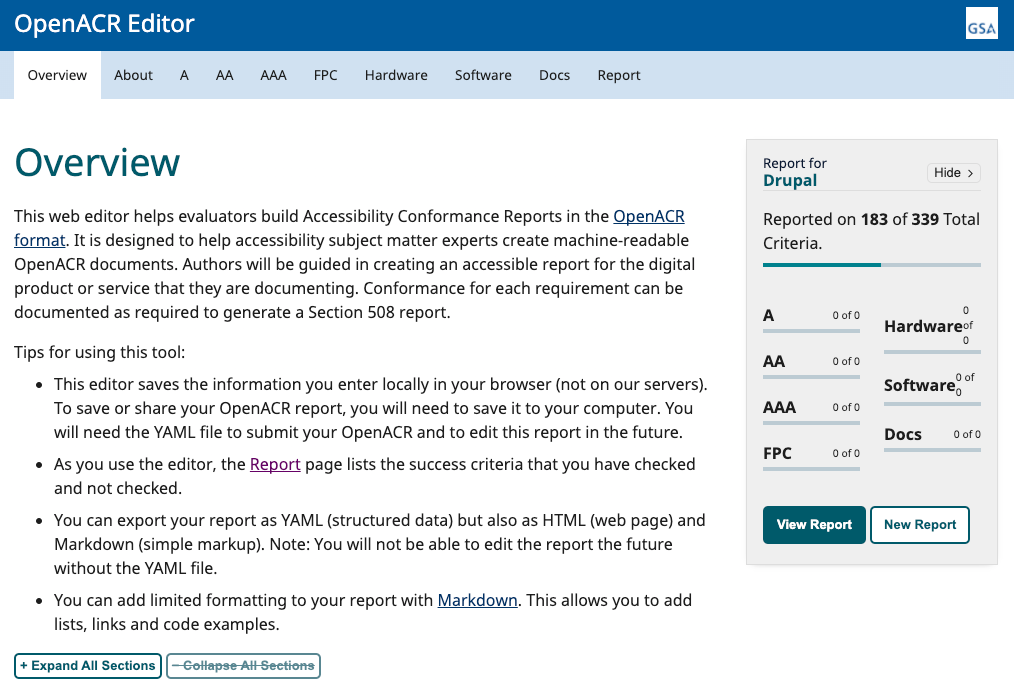Accessibility Accelerator
OpenACR (Accessibility Conformance Reporting)Modernizing the ACR (Accessibility Conformance Reporting) Process
The challenge
To ensure products used by the government are accessible, vendors must submit accessibility conformance reports (ACR) to demonstrate their products meet Section 508 requirements. The most commonly used ACR follows the Voluntary Product Accessibility Template (VPAT), a templated Word Document or PDF that software vendors fill in manually, and often is not an accurate representation of product accessibility.
The ACR process is inconsistently structured, not searchable, static, and with no version control. For this reason, providing more accessible services can be complex and disempowering for vendors and procurement officers. The General Services Administration (GSA), which manages and supports the basic functioning of federal agencies, was interested in finding ways to modernize the ACR process. After requesting a Market Research Request for Information (RFI), we responded with the concept for OpenACR, a tool that simplifies the process of finding, sharing, and maintaining accurate and actionable data about product accessibility. After GSA reviewed potential solutions, CivicActions was awarded the contract for our innovative approach.

Expertise
- Accessibility, Section 508/WCAG
- VPAT/ACR reporting
- Information Architecture
- Prototype Development & Testing
- Usability testing
- User and Stakeholder Research
- Automated Testing
Tools and technologies
- Node
- YAML and JSON
- JavaScript/TypeScript
- Svelte
- HTML and CSS
- Handlebars
- U.S. Web Design System (USWDS)
- GitHub Actions and Pages
Our Approach
Our team, led by Senior Strategist and accessibility expert Mike Gifford, realized that the process of managing ACRs hadn’t kept up with the nature of modern software development. Leveraging the YAML machine-readable language, the team created a highly structured report format that can be easily exported to an accessible and readable HTML document.
OpenACR, Open Source
Our team was excited to do the development process in the open. OpenACR is open source, so other organizations and members of the open source community are free to generate input and build on OpenACR’s source code. Subject Matter Experts (SMEs) worldwide have contributed to the development of this new tool, and all are welcome to visit the open issue queue to add feedback.

Foundational Accessibility
OpenACR sets a new standard for foundational accessibility. By building a machine-readable ACR, OpenACR allows for developing a central directory of accessibility standards for software used by the government. This is a significant milestone in standardizing accessibility practices and simplifies the process of communicating product accessibility for vendors and government IT buyers.
Key outcomes
Radically Improving Accessibility
OpenACR can reshape how procurement officers worldwide choose software for their organizations’ needs. By selecting more accessible tools, more organizations can set a higher standard of accessibility and health equity.
Cost and Time Savings Consolidation Tool
OpenACR includes a collection of tools that supports editing and validating Accessibility Conformance Reports (ACRs). The tools will eventually allow procurement officers to find, search, and compare accessibility reports with higher accuracy while simplifying the process for IT vendors to create useful ACRs, resulting in saving time and money.
Standardized, Machine-Readable ACR
Our team designed OpenACR to help Accessibility Subject Matter Experts (SMEs) create machine-readable documents built with YAML. This can be easily exported to an accessible and readable HTML document. The YAML format can also be easily imported and modified.
Open Source
Open ACR is an open source project, so other organizations are free to extend and improve the project.
Foundational Standards
OpenACR can produce ACRs for Section 508 compliance but supports Web Content Accessibility Guidelines (WCAG) 2.0 and WCAG 2.1 Success Criterion. The final HTML version follows the standard VPAT format.



